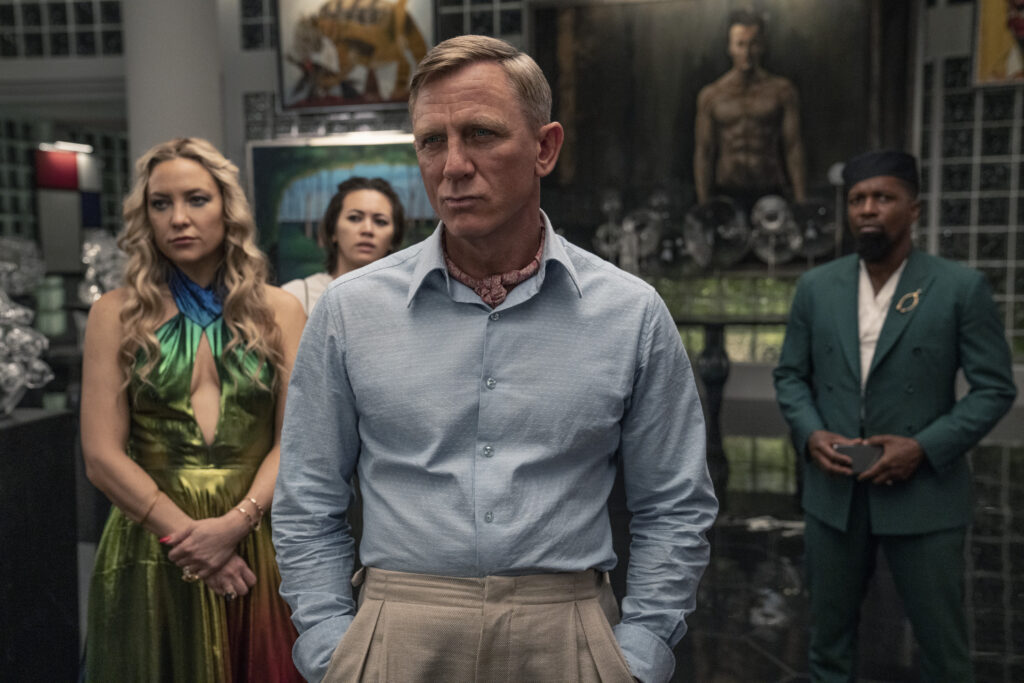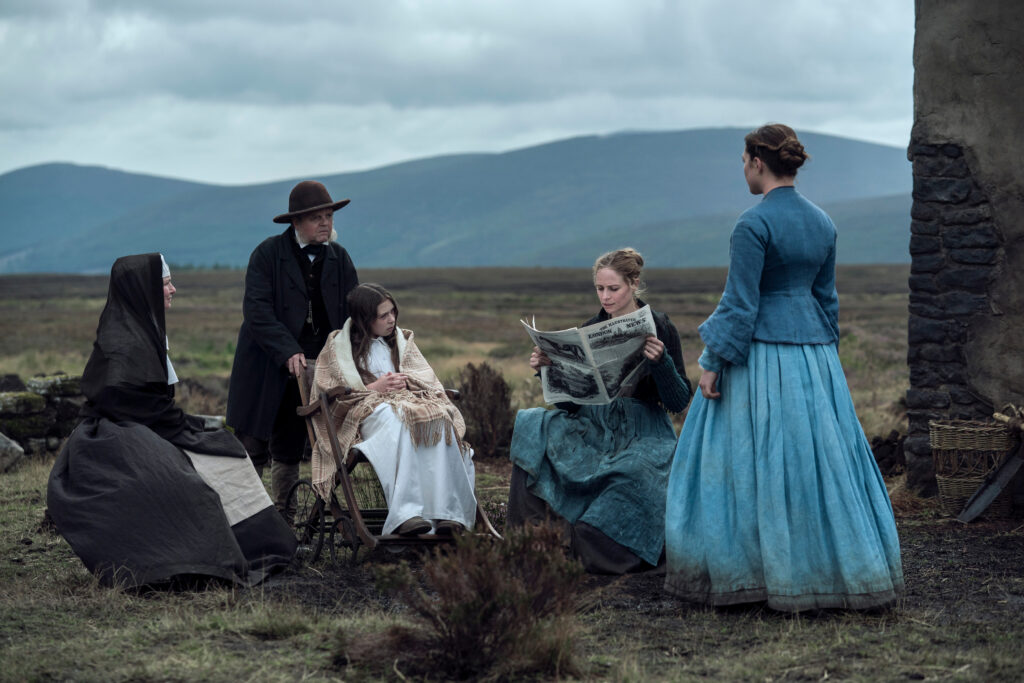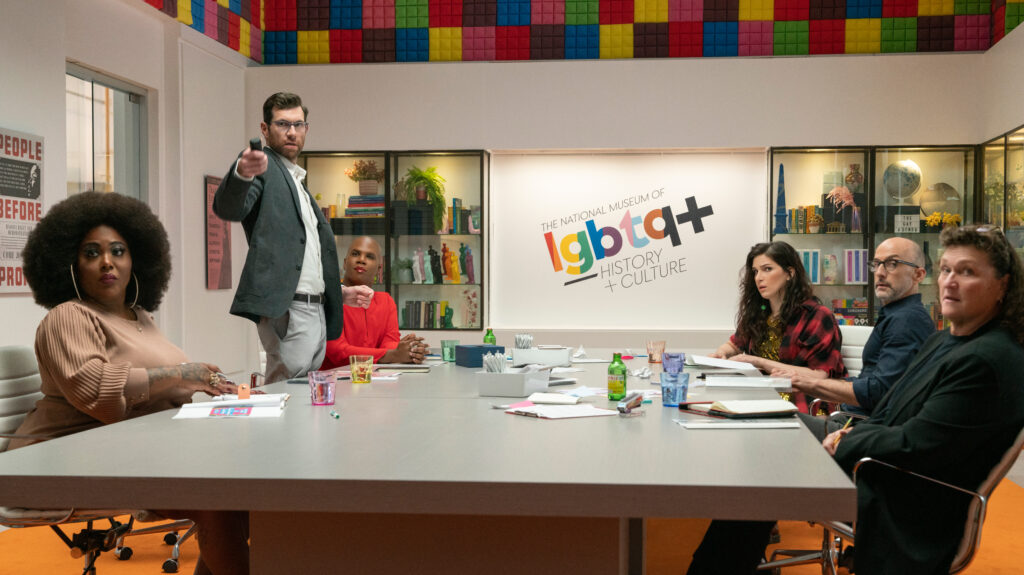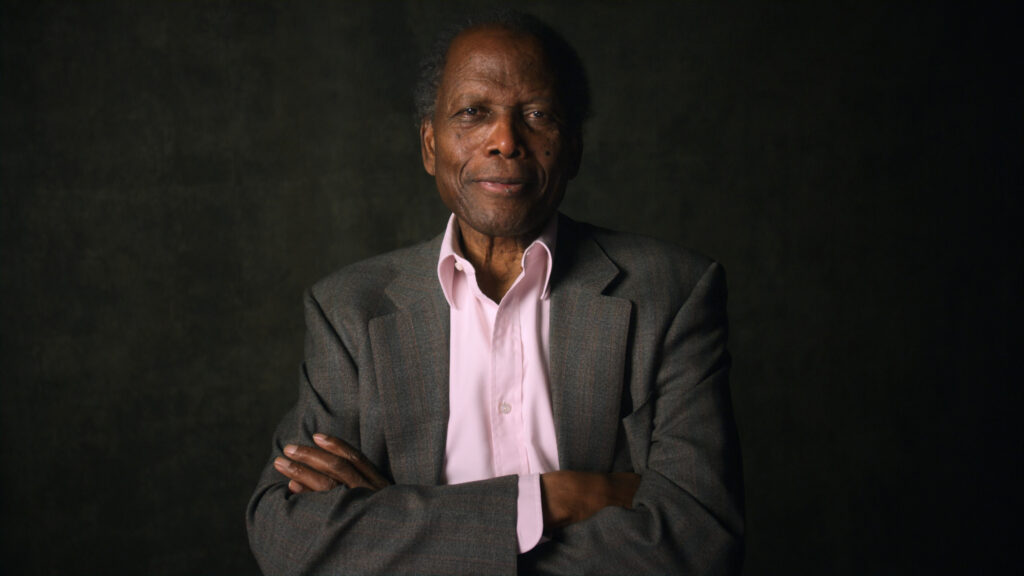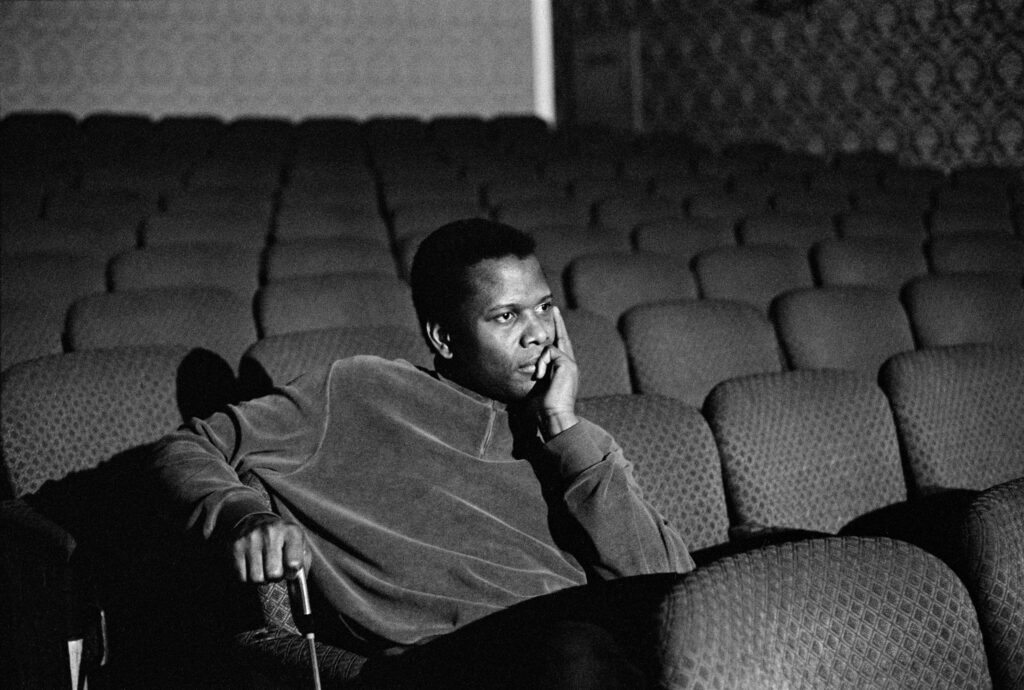November 25, 2022
by Carla Hay

“All the Beauty and the Bloodshed”
Directed by Laura Poitras
Culture Representation: The documentary film “All the Beauty and the Bloodshed” features a predominantly white group of people (with one African American and one Asian) discussing the life and career of New York City-based artist/photographer Nan Goldin, who became an activist speaking out against the wealthy pharmaceutical Sackler family’s role in creating the opioid epidemic in the United States.
Culture Clash: Goldin (who is a recovering opioid addict) led protests and boycotts to remove the Sackler family name from prominent buildings, to have Sackler family donations rejected, and for the Sackler family to be held accountable for flooding the marketplace with prescription opioids, while also using her art and celebrity to express her greatest passions.
Culture Audience: “All the Beauty and the Bloodshed” will appeal primarily to people who are interested in learning more about Nan Goldin and how artists become activists.

The documentary “All the Beauty and the Bloodshed” is a fusion of a revealing biography of photographer Nan Goldin and an impressive chronicle of her activism against pharmaceutical moguls, especially Purdue Pharma’s Sackler family, whom she blames for the opioid crisis. Goldin is very candid about being a recovering opioid addict and about other struggles in her life, including her mental health issues, her turbulent love life (such as being a domestic violence survivor of an ex-boyfriend), and her still-unresolved turmoil about the suicide of her older sister Barbara. “All the Beauty and the Bloodshed,” which was filmed mostly from 2017 to 2021, shows what happens when an artist does more than just talk about making a difference in social justice issues but actually becomes an agent for change in these issues.
Directed by Laura Poitras, “All the Beauty and the Bloodshed” had its world premiere at the 2022 Venice International Film Festival, where it became a rare documentary to win the Golden Lion, the festival’s top prize. “All the Beauty and the Bloodshed” has since made the rounds at several other festivals, including the Toronto International Film Festival, New York Film Festival, the Austin Film Festival and DOC NYC. It’s a documentary that covers a lot of issues, sometimes in a way that’s jumbled and messy, but no one would ever describe Goldin’s life as neat and tidy.
Goldin, who was born in 1953, is the narrator of the documentary, which jumps around in the timeline of her life story. Goldin has a gravelly voice that comes from years of smoking cigarettes, fast living and surviving traumatic experiences that would kill many other people. She comes across as jaded but hopeful, world-weary yet determined to fight for the causes that mean the most to her. The scenes of Goldin being an activist are interwoven with her telling stories about her personal life.
“All the Beauty and the Bloodshed” opens with a visually striking scene of a Goldin-led protest at the Metropolitan Museum of Art in New York City on March 10, 2018. In this scene, dozens of protestors have gathered in a museum atrium to throw empty prescription bottles in a water fountain while chanting, “Temple of money, temple of greed!” and “Sacklers lie, people die!” The atrium is in a section of the museum named after the Sackler family, the wealthy American clan that owns Purdue Pharma and Mundipharma. Purdue Pharma is the manufacturer of OxyContin. The protesters have gathered to demand that the museum remove the Sackler family name from anywhere in the museum.
The protesters lie down on the floor to represent the people who died from overdoses of OxyContin and other prescription drugs. As far as the protestors are concerned, any the Sackler family’s donations and philanthropic actions are tainted by “blood money” generated from the millions of lives destroyed by addictions to OxyContin and other opioids manufactured and marketed by the Sackler family’s pharmaceutical businesses. The protesters are eventually escorted out by the museum’s security personnel, but the documentary shows what eventually resulted from these kinds of protests.
In 2017, Goldin and some of her colleagues founded Prescription Addiction Intervention Now (P.A.I.N.), a group dedicated to preventing and reducing harm from prescription drug addiction, as well as shaming the greedy people who over-sell and over-prescribe these highly addictive drugs to vulnerable people. “All the Beauty and the Bloodshed” documents how P.A.I.N. staged protests at museums in various international locations, including the Louvre in Paris; the Victoria & Albert Museum and the National Gallery in London; and the Guggenheim in New York City.
P.A.I.N. put pressure on these museums and other institutions to refuse donations from the Sackler family and to remove or prevent the Sackler name from anything associated with these institutions. This activism created worldwide awareness about the Sackler family putting the Sackler name on philanthropic causes, in the family’s attempts to deny or avoid responsibility for the opioid crisis. Goldin comments in the documentary about the Sackler family: “We will target their philanthropy. They have washed their blood money through the halls of museums and universities around the world.”
The U.S. government’s legal prosecutions of certain members of the Sackler family have been well-documented, but “All the Beauty and the Bloodshed” puts a spotlight on Goldin and P.A.I.N.’s grassroots work in getting this prosecution to even take place. This behind-the-scenes look has the added benefit of Goldin’s participation, because her narration gives a very personal and touch that would be missing if she had not been actively involved in making the documentary. Goldin and Poitras are among the producers of “All the Beauty and the Bloodshed.”
Early on in the documentary, Goldin comments: “It’s easy to make your life into a story. It’s harder to sustain real memories. The difference between the story and the real memory: The real experience has the smell and is dirty and is not wrapped up in simple endings. The real memories are what affects me now. Things can appear that you don’t want to see. You’re not safe.”
In “All the Beauty and the Bloodshed,” Goldin dredges up a lot of unsafe memories, beginning with her childhood, which she describes as living in a “claustrophobic suburb.” Goldin was born in Washington, D.C., but spent most of her childhood living in the Boston suburbs of Swampscott and Lexington in Massachusetts. Her father was Goldin’s father worked in broadcasting and was the chief economist for the Federal Communications Commission. Her mother was a traditional homemaker.
Goldin’s older sister Barbara, who was seven years older than Nan, was a lesbian and was shamed by their parents about her sexuality. It was during a time when homosexuality was considered a mental illness, so Barbara was forced into a psychiatric institution for a certain period of time. Goldin believes this institutionalization caused further damage to an already mentally fragile Barbara, whom Goldin says had depression and anxiety. Goldin remembers that their mother used to say about Barbara’s sexuality: “Don’t let the neighbors know.”
Goldin shares fond memories of Barbara, whom she considered to be more of a mother figure to her than their own biological mother. “Barbara had a wildness to her,” Goldin says. “You couldn’t hold her back … She trusted me with all of her secrets.”
Goldin also remembers Barbara’s talent for playing classical music on the piano. “You could always tell how she felt by how she played,” Goldin says. “I felt very close to her, but she was in and out of institutions for most of her childhood.”
Tragically, Barbara committed suicide in 1964, at the age of 18. Goldin says with some bitterness, “I heard my mother say, ‘Tell the children it was an accident.’ She didn’t want us to know the truth. That’s when it clicked.” Goldin says in the documentary that Barbara probably wouldn’t have committed suicide if Barbara had a support group for LGBTQ teenagers and other young people. Those support groups didn’t exist in most places in 1964.
By the age of 13 or 14, Goldin left home. At 16 years old, she was enrolled at Satya Community School in Lincoln, Massachusetts, when a school employee introduced Goldin to photography. Thus began Goldin’s lifelong passion for telling visual stories through photos. She began documenting her life in photos, long before it became a common way of life for people in the era of the Internet and social media.
By the time Goldin was in her late teens, she was living in Boston as part of an avant-garde artist scene that she chronicled in her photography. Long before drag queens became part of mainstream media, Goldin had a particular affinity of taking photos of drag queens and transgender women, many of whom were friends of hers. In the documentary, Goldin talks about being in awe of a transgender woman named Bea, who became Goldin’s friend and roommate. Goldin’s first solo exhibit in Boston was in 1973, when she was 20 years old.
Goldin eventually relocated to New York City, the center of the art world in the United States. Life wasn’t glamorous at all in those early years when she was a a struggling artist. Goldin talks about living in New York City’s seedy Bowery district and having a drug-fueled lifestyle that included abuse of cocaine and methamphetamine. To pay her bills, Goldin says she became a nightclub go-go dancer then later became a brothel prostitute.
Goldin says, “Sex work is one of the hardest jobs you could ever have.” She also mentions that she wanted to talk about her past as a sex worker in this documentary, in order to get ride of the stigma and shame that is often associated with sex work. Eventually, Goldin became a bartender at the women-controlled nightclub Tin Pan Alley, whose owner hired people who wanted to transition out of sex work. Author/playwright Darryl Pickney says that Tin Pan Alley was very racially integrated and cut across social class boundaries.
One of the people in the New York City art scene who had a bg influence on Goldin was Cookie Mueller, whom Goldin describes in the documentary as “the center of downtown life. “The mid-1980s was when I was closest to Cookie.” Their friendship changed somewhat after Mueller married Italian artist Vittorio Scarpati in 1987. Tragically, Mueller and Scarpati died of AIDS-related illneses, just two months apart in 1989.
The documentary includes footage of Goldin’s activism in AIDS causes, including working with fellow activist/artist David Wojnarowicz. They were both heavily involved in the AIDS activist group ACT Up. In the documentary, Goldin describes Wojnarowicz as “my spiritual guide, my political guide.” (The 2021 documentary “Wojnarowicz,” directed by Chris McKim, has more information.)
Goldin and Wojnarowicz worked on an AIDS-themed artist installation that was scheduled to be at the Artist Space Gallery in New York City’s Tribeca neighborhood from November 1989 to January 1991. However, the National Endowment of the Arts controversially cancelled its grant funding for the project after getting pressure from conservative religious groups. Goldin says of the AIDS installation: “It was about the loss of community and trying to keep people’s legacy alive.”
She describes her history of drug abuse in matter-of-facts terms. Goldin says that she went to rehab for the first time in 1988. For a period of time that she does not fully disclose, she says she was addicted to OxyContin, a drug that went on the market in 1996. Goldin says that she is now clean and sober, but she firmly believes that she and an untold number of OxyContin addicts were deliberately not properly informed by medical professionals about how addictive OxyContin is, because too many people were and still are getting rich from OxyContin sales.
Goldin, who identifies as queer, also opens up about her love life. She talks about being in an abusive relationship with a man called Brian, whom she says she dated from 1981 to 1984. “I fell in love with him,” Goldin comments. “We had very good sex, and that can keep people together for a long time. And then, we started fighting.” Their troubled relationship included domestic violence.
Goldin describes a trip that she and David took to Provincetown, Massachusetts (a popular vacation spot for LGBTQ people), and jealousy issues arose because Goldin says she fell in love with a woman during this trip and photographed this woman constantly. Goldin, who does not name the woman, describes her as an “oddball” who would wear pearls at the beach. Goldin says about the early-to-mid-1980s: “It was a time of freedom and possibility. That’s when I did my first slide shows.”
Although Goldin’s career was on the rise in the early-to-mid-1980s, her relationship with David wasn’t getting any better. Goldin says that David broke up with her because he found out “I’d been with this girl.” (Goldin does not name this other lover.) She goes on to say about David, “He punched me in the face repeatedly.” To add insult to injury, David burned a lot of Goldin’s photos.
Most victims of domestic violence would hide this abuse, but Goldin made the very bold and unusual decision to do a photo exhibit showing her bruised and battered face from the injuries that David inflicted on her during this vicious attack. These photos were included in her ongoing photography collection “The Ballad of Sexual Dependency,” which started out as a slide show exhibition and film in 1985, and then became a published book in 1986.
More than 700 photos are in “The Ballad of Sexual Dependency,” which Goldin describes in the documentary as “the struggle between autonomy and dependency.” “All the Beauty and the Bloodshed” includes many samples of Goldin’s work over the years, including photos from “The Ballad of Sexual Dependency”; “The Other Side,” a photo collection of drag queens from 1992- 2021; and “Sisters, Saints and Sibyls,” a photo collection from 2004 to 2021. The photos showcase Goldin’s penchant for documenting herself and other eccentrics in ways that can be gritty, glamorous or both.
In the documentary, Goldin gives a reminder that back in the 1970s and 1980s, she got a lot of resistance to her art because of sexism. She says many people told her, “Nobody photographs their own life.” And it was even rarer for women to want to make a living from this type of photography. Goldin says for some people who were born after the 1970s and 1980s, “It’s hard to understand that could’ve ever been radical.” Long before Instagram was even invented, Goldin was ahead of her time.
Because “All the Beauty and the Bloodshed” weaves in and out of telling Goldin’s stories about her personal life and her activism, the film editing sometimes gives the movie a rambling tone, but it never derails too far off course. One of the documentary’s highlights is a videoconference call in which Goldin and other people affected by OxyContin addiction confront David Sackler and his aunt Theresa Sackler (two of the Sackler family defendants named in many lawsuits) to give a victim/survivor statement. Even though the Sacklers were not allowed to respond to these statements during this conference call, it’s a powerful moment that contrasts the Sacklers’ emotional aloofness with these survivors’ emotional pain.
Goldin, who has never been married and doesn’t have children, has this to say about her personal life: “The relationships that have mattered the most to me for probably my whole life have been my friends.” The documentary gives the impression that most of Goldin’s closest friends are also her P.A.I.N. colleagues.
Some of the P.A.I.N. members interviewed in the documentary include P.A.I.N. deputy Megan Kapler, artist Maria Berrio, P.A.I.N. deputy Harrison “Harry” Cullen and psychiatrist Annatina Miescher. The documentary includes a segment about how some of the P.A.I.N. activists believe that they were stalked and spied on by people hired by the Sackler family. Kapler shares footage of an unidentified middle-aged man who followed her and photographed her without her consent. He also staked her out in his car outside of her home.
Other interviewees in the documentary include Ad Hoc Committee of Accountability attorney Mike Quinn, who does a lot of pro bono work for P.A.I.N.; Robert Suarez of the Urban Survivors Union, a non-profit support group for drug addicts; Artforum International magazine editor-in-chief David Velsaco; TruthPharm executive director Alexis Pleus; set designer/interior decorator Noemi Bonazzi; actress Sharon Niesp; writer Patrick Radden Keefe; and actress Maggie Smith.
“All the Beauty and the Bloodshed” also shows the next big initiative for P.A.I.N. is removing the stigma of doctors treating opioid addicts who are in clean needle programs. And one of the final scenes in the film shows P.A.I.N. raising $35,000 for Urban Survivors Union to purchase a machine that gives drug users an analysis of the content in their drugs. This machine does not encourage drug use but is aimed at preventing deaths when people unknowingly ingest drugs with lethal content.
People who know about Goldin before seeing “All the Beauty and the Bloodshed” might not be as surprised by her unique personality, her artistic talent and her unwavering commitment to the causes that she cares about the most. However, what will resonate with viewers the most is how someone who has experienced as many highs and lows as Goldin has can take those experiences and turn them into something positive that can help other people. No matter what type of backgrounds that people have, “All the Beauty and the Bloodshed” is an inspirational story that shows the true meaning of persistence and hope.
Neon released “All the Beauty and the Bloodshed” in New York City on November 23, 2022. The movie’s U.S. release expands to Los Angeles and San Francisco on December 2, 2022, with more cities added on December 9, 2022.

